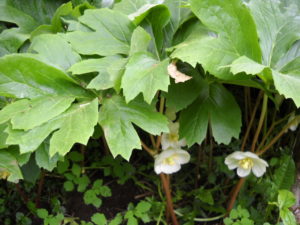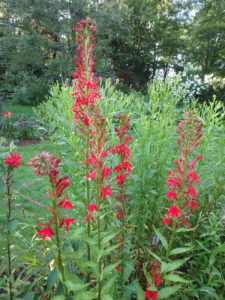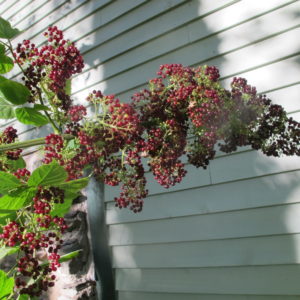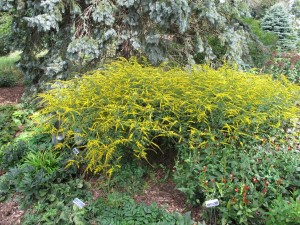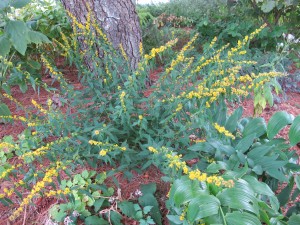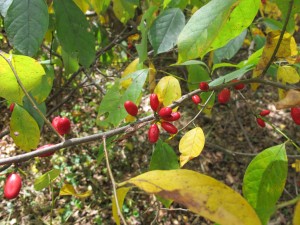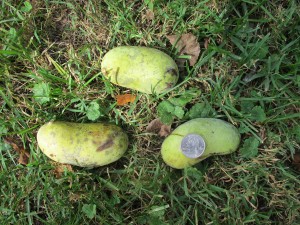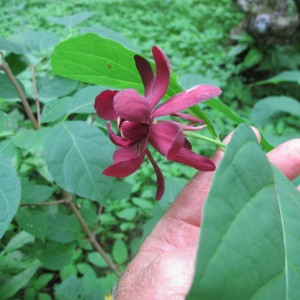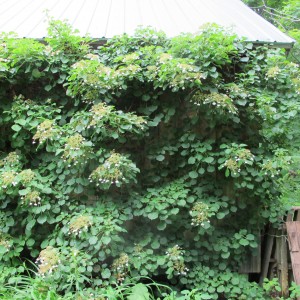Native Plants for New England Gardens
It’s rare that I find a book that is as useful, accurate and easy-to-read as Native Plants for New England Gardens by Mark Richardson and Dan Jaffe, both on staff at the New England Wild Flower Society in Framingham, Massachusetts. This book presents over 100 species of wildflowers, trees and shrubs, grasses, ferns, vines and lianas (woody vines). And even though I grow the vast majority of plants in this book, I learned so much that I felt like a third grade boy on an outing with a PhD.
First, the authors define native plants: those that were growing in North America when the first colonists arrived. They stress, right off the bat, that it is important to put the right plant in the right place. Instead of shopping for pretty flowers, they recommend knowing about plants and seeking them out. The glossy photos of the book will help you put together a plant list; their instructions will help you decide if you have a place for a particular plant.
I have always enjoyed eating wild harvested plants. The book covers ramps, which I grow, but also other wild edibles I grow – including two that I didn’t know are edible.
I have a large patch of Mayapple (Podophyllum peltatum). As the authors point out, it spreads robustly and shades out other plants. The blossoms appear beneath the big, wide leaves and are not easily seen; they suggest planting it on a steep incline, so that one can see them – and the fruit, bright red “apples” when standing below the planting. I have seen the fruit, but never knew it was edible until reading about it. Apparently the fruit is also eaten by box turtles. Who knew? Note: “Since writing this, I read elsewhere that that the seeds and rind may be toxic, so better to avoid eating May apples.”
Another edible fruit described in the book is produced by American spikenard (Aralia racemosa). The authors note that spikenard gets big enough to serve as a handsome shrub, but since it dies back to the ground each fall, it won’t be damaged by snow falling off your roof if you plant it near the house. I grow it in part shade and it gets to be 6 feet tall and wide, and produces masses of berries each fall. The berries start off white, change to red, and end up a deep purple. I shall taste them this fall.
I grow all 3 of the milkweeds described in the book: common, swamp or rose, and butterfly milkweed. The authors explain the pluses and minuses of each, where to plant them. “If you are looking for a well-behaved garden plant, then common milkweed is not the best choice.” It spreads by root, they explain and is suited for “meadows, hell strips or as competition against invasive species.”
Yes, I knew that milkweeds are essential for monarch butterflies, but they point out that they also support tussock moths, swallowtails, and a variety of beneficial beetles. “The plant (swamp milkweed) seemingly supports whole ecosystems on its own, often playing host to bees, ants, and various spiders waiting to eat an unsuspecting pollinator.”
I love cardinal flower (Lobelia cardinalis) and have grown both the native species and modern hybrids varieties in a moist, full-sun garden. I no longer grow the hybrids, as they are less hardy than the native species and have all died out. The authors refer to work done at the University of Vermont that showed that at least one of the hybrids produced only 20% of the nectar energy produced by the wild species. So hummingbirds, who love these bright red flowers, get something akin to diet nectar if you grow the hybrid variety. It’s best to avoid planting them, so read the plant tags carefully before buying.
I love the bright red leaves of staghorn sumac (Rhus typhina) growing by the side of the road, but would never consider planting it on my property. Although a native plant with fruit beloved by returning migratory birds in early spring, it can spread very aggressively and is hard to remove. But the authors introduced me to another variety, fragrant sumac (Rhus aromatica), that is smaller, “much slower growing, and fairly easy to control even in a formal garden setting.” I shall look for it, and try to learn from others who have grown it (Please e-mail me if you have grown it).
I grew up in Connecticut where spicebush (Lindera benzoin) was a wild shrub with tasty leaves and twigs that I chewed as a breath freshener. But it is hardy to Zone 4, and I got one two years ago. According to the book, it is an understory shrub that does well in moist soil. I knew it as a plant for dry shade, and hence planted it here in a dry location, and it has done fine.
What I did not know, until reading Native Plants for New England Gardens, is that spicebush is dioecious – there are male and female plants. That would explain why I have not gotten any of the bright red berries used by the authors in a tea that is “magical for fighting off the common cold and is packed with vitamin C.” I shall get another, and hope for pollination.
One last tip from the book: if you want to grow wintergreen, a low-growing ground cover with tasty red berries, plant it under your blueberries. The sulfur you give your blueberries will make the soil right for wintergreen.
I loved this book. I predict you will, too. And come spring, I’ll go to the Garden in the Woods in Framingham, MA (where the authors work) and buy some wildflowers in the nursery there.
You may e-mail Henry at henry.homeyer@comcast.net or write him at P.O. Box 364, Cornish Flat, NH 03746. Please include a SASE if you want a response by USPS mail.
Learning on the Road
I’m not much of a country music fan, but do love Willy Nelson’s “On the Road Again” – probably because I love to travel. Recently I’ve been on the road again, visiting friends and family in Pennsylvania and Ohio, traveling by car. Unlike Willy, it’s not the honkytonks or making music that interests me, it’s the public gardens, garden centers and private gardens. There is always something to learn.
While in Pennsylvania I visited Longwood Gardens in Kennett Square. These are at the home of the late Pierre S. Dupont which have been open to the public since the 1920’s. The gardens are largely formal, with huge expanses of lawn, fountains, shaped hedges and trees, ancient tulip poplars, displays of perennials, annuals, wonderful long shaded walkways, experimental plots and even a vegetable garden. A new addition is an 86-acre meadow, allowed to grow up in wild plants including many called weeds by gardeners. Right now dominant species include golden rods, fall asters and tall grasses.
Meanwhile, at the home of friends nearby, I spent time in a smaller version of the Longwood Meadow. Lisa and Chris Brinton bought a run-down farm about 30 years ago and have been working on it ever since. For the past decade that included bringing back to life a few acres of field that had been farmed for corn until the soil was depleted. When they bought the place the soil was so poor that even weeds had a hard time growing.
What struck me about their meadow was the number of bees, birds and butterflies. The field had been allowed to grow up in milkweed, goldenrod and native grasses. Trees that attract wildlife had been planted or allowed to colonize. It was a slow process as they didn’t bring in new topsoil, they just allowed leaves and grasses to decompose where they landed each fall and winter. Slowly the land came back to life. Mother Nature was allowed to reclaim the land.
Goldenrod gets a bad rap from most gardeners, but there are some varieties that are well mannered and beautiful at this time of year. I visited North Creek Nursery in Landenberg, Pennsylvania .This wholesale nursery grows hundreds of kinds of native plants, including half a dozen different kinds of goldenrod. Unlike the 5 to 6 foot giants that try to muscle their way into my gardens, they had some nice smaller varieties of goldenrod that I plan to grow.
Among their goldenrods there is an 18 to 36-inch tall shade-loving goldenrod, Solidago caesia, that I grew for some years before it was weeded out by a well-meaning helper. It’s hardy to Zone 4 and it thrives in dry shade. The small blossoms appear all the way up the stems. I also loved ‘Fireworks’ (a variety of Solidago rugosa). It stands about 3 feet tall, and prefers average to moist soils in full sun to half shade. Its blossoms are distributed along the stems, which arch out from this clump-forming perennial.
Of the various ornamental grasses I saw in the trial gardens at North Creek, my favorite was a little blue stem (Schizachyrium scoparium) called ‘Standing Ovation’. It is a North Creek introduction that is said to stand up well all year and at this time of year is a handsome reddish purple. It is hardy to Zone 3, meaning it will survive even our coldest winters.
Visiting friends in Athens, Ohio I liked the way my friends had terraced their gardens – without spending a fortune. Stone walls are great for creating terraces, but many of us cannot afford to make the investment. My friends used cement blocks that came with faux-stone fronts. The blocks stack nicely and lay flat, and hold back the soil to create level gardens. I have never worked with landscape blocks of this sort, but see that they are a good building material that is easier to work with than the irregular sizes and shapes of real stone.
Also in Ohio I saw spicebush (Lindera benzoin), a native understory shrub that has flavorful leaves and seeds. At the farmers market in Athens I bought some dried leaves for tea, and then saw it growing in the woods at my friends’ house. The bright red berries are very attractive right now, and I am told they can be used to flavor gin or as a substitute, dried and ground, for allspice. Birds love the seeds, robins in particular, and strip the berries in the fall when other foods become scarcer. Spicebush is a favorite food plant of two butterflies: the spicebush swallowtail and the promethea silkmoth. Spicebush is hardy to zone 4, and I definitely want to plant one.
In both Ohio and Pennsylvania I got to eat the fruit of the pawpaw tree (Asimina triloba). Pawpaw is a native fruit tree with fruit that is flavored somewhat like a cross between a banana and a mango. The flesh is mushy, and seeds are large. It is hardy to Zone 4, though not commonly grown in New England. I got a couple of small pawpaw trees early this summer, and one day maybe I’ll get fruit from my own trees.
Being a serious gardener means wherever I go I’ll have something interesting to see – and learn about.
Henry is the author of 4 gardening books. His Web site is www.Gardening-Guy.com. Contact him at henry.homeyer@comcast.net.
Trees and Shrubs for the Shade
I grew up in a small town in rural Connecticut. Behind the house there was a brook and a hardwood forest with a high canopy of old maples that created a cool space for spending hot summer days. My favorite understory tree was a small, bushy tree that had very fragrant leaves and stems, which I decided must be witch hazel, as the barber splashed witch hazel on my neck after each haircut, and it was vaguely the same. I frequently chewed on the leaves and green twigs in lieu of the chewing gum that was forbidden to me.
This summer I discovered the name of that plant: spicebush (Lindera benzoin). One of my gardening clients had requested one for her garden, and as soon as I crushed a leaf, I was transported back 60 years. I knew it immediately. Most winters my part of New Hampshire drop to minus 25 degrees Fahrenheit, so any plant that will survive here must be rated for Zone 4 (Minus 20 to minus 30). I checked my favorite tree book (Michael Dirr’s Manual of Woody Landscape Plants), and sure enough, spicebush is rated for Zone 4. I will get my own as soon as I find the right place on my property to plant it.
From Dirr’s book I learned that spicebush can get to be up to 12 feet tall and wide, and is in the laurel family. There are 80 species of Lindera, both deciduous and evergreen (L. benzoin is deciduous). Apparently it blooms in early spring but the yellow blossoms are only one fifth of an inch across, so not overwhelming (I have no memory of it blooming). Fall leaf color is yellow. Dirr’s book says it does well in moist, well drained soils in full sun or half shade, though in my experience it will do well in dry shade in open woodlands. Dirr says spicebush is not often found in nurseries, but E.C. Brown’s Nursery in Thetford, VT has several nice ones.
Another woodland plant that I would like to try is leatherwood (Dirca palustris). Like spicebush, this is a native shrub that will grow in shady areas but this one prefers moist to wet soil – and I have plenty of that. Apparently it only gets to be 3 to 6 feet tall and wide, and is more open and spreading in shade than in sun. It is has small yellow flowers that bloom very early in the spring, well before the leaves emerge. Native Americans used the bark to make bow strings, fish lines and in the manufacture of baskets. Tough stuff.
Three years ago I planted a sweetshrub or Carolina allspice (Calycanthus florida). The first 2 years I grew it in full sun with deep, rich moist soil. Both years the leaves yellowed – as if the sun were too strong and bleached them out. So last fall I moved it into a grove of old wild apples that provide full shade, and it seems to be doing much better. It is blooming now, and has put on considerable new growth.
Sweetshrub grows to be 6 to 9 feet tall with a 6 to 12 foot spread. Some varieties have very fragrant flowers, but mine is not. Dirr’s book suggests buying the shrub is in bloom in early summer, as the fragrance varies from plant to plant. It is adaptable to acid or alkaline soils, and is hardy to Zone 4.
Mountain laurel (Kalmia latifolia) is another fabulous shrub that will grow in deep shade (or even full sun), and I have grown it these past 20 years or so, even though I am on the northern edge of where it is successful. Mine produces delicate three-quarter inch diameter flowers, cups of white with pink veins. After cold winters I don’t always get flowers. There are cultivars with flowers in white to rose, and everything in between. Definitely buy when blooming. It does best in acidic soil that is cool and lightly moist. I have seen it growing abundantly in the wild at Sleeping Giant State Park in Hamden Connecticut, where there is a high, dry, open hardwood forest.
Of all the shade-growing woody plants, the most dramatic on my property is the climbing hydrangea (Hydrangea anomala subsp. petiolaris). I have vines that completely cover the north side of my barn – and that only get a few hours of sun each day. It is in bloom now, with flower corymbs (flat topped inflorescences) that have both fertile and sterile (showy) blossoms and are 6 to 10 inches across.
Climbing hydrangea is slow to get established – mine took 6 years – but once it begins to grow, it quickly covers a surface. It will attach itself to stone or brick, but needs to be strapped onto wood surfaces, at least at first. Mine has grown through the cracks on the barn and is now self-supporting. Its vines can grow 60 feet or more, and has support arms for its flowers that reach straight out from the barn that are up to 3 feet long. It is truly dramatic.
So don’t despair if your property is mostly in the shade. There are these plants, and lots more, that will amaze and delight you.
Henry Homeyer is the author of 4 gardening books. His Web site is www.Gardening-Guy.com.



